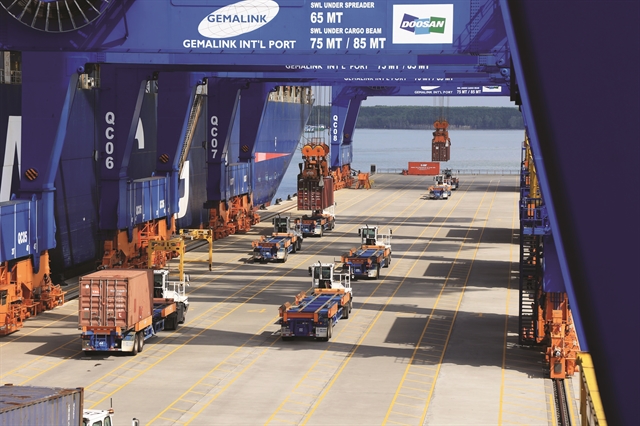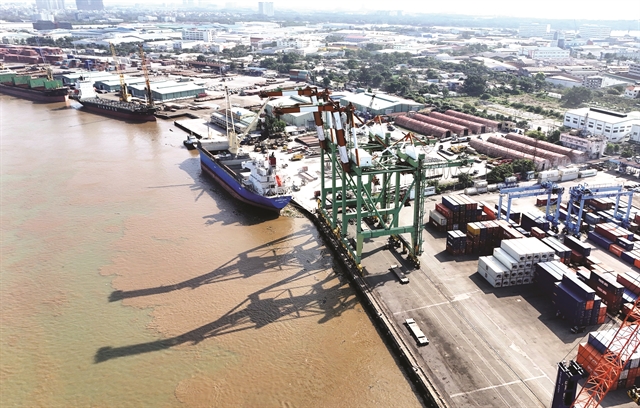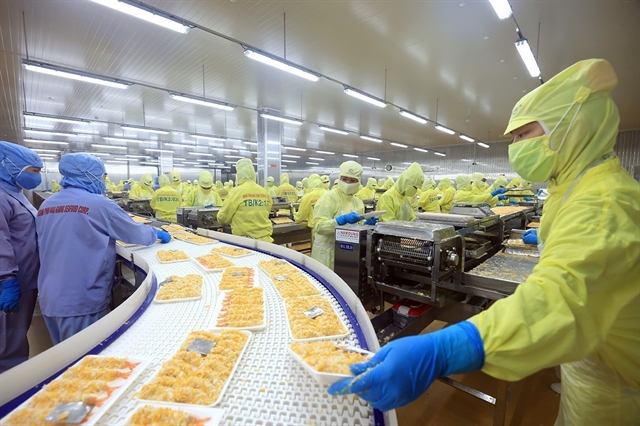 Economy
Economy

 |
| Containers of export goods are uploaded at Gemalink international port. — VNA/VNS Photo |
By Ly Ly Cao
The ongoing eye-catching headlines surrounding US President Donald Trump’s on-again, off-again tariffs since his return to the White House have created waves of uncertainty across the globe.
The announcement of sweeping US tariffs in early April sent tremors through the global trading system, with Việt Nam among the hardest hit.
However, in a display of diplomatic agility and strategic foresight, the Vietnamese Government responded swiftly. Within hours, it mobilised a high-level effort to initiate dialogue with Washington, signalling its readiness to negotiate and protect national economic interests.
Trump subsequently reduced new tariff rates on imports from most US trade partners, including Việt Nam, to 10 per cent for a 90-day period to allow space for negotiations.
Now the big question Việt Nam faces is how to address the US tariffs within this 90-day window. The answer lies not only in diversifying trade partners, but also in unlocking the full potential of its domestic market.
 |
| Cargo ships carrying import and export goods dock at the multi-purpose port along the Saigon River in HCM City. — VNA/VNS Photo |
Diversifying trade partners
At an April 10 meeting with cabinet members and leaders from ministries, sectors, and localities, Prime Minister Phạm Minh Chính ordered the immediate formation of a negotiating team, led by the Minister of Industry and Trade, to begin discussions with the US.
He emphasised that these negotiations must be framed within the broader context of Việt Nam’s global trade landscape, including its 17 existing free trade agreements (FTAs).
Chính also said that this challenge presented an opportunity to restructure the economy towards rapid and sustainable growth, while reorganising enterprises and diversifying products, markets, and supply chains.
Michele D’Ercole, chairman of the Italian Chamber of Commerce in Việt Nam, said: “This swift reaction gives us confidence to continue to stay in this country. “The Government’s actions to mitigate the impact were appreciated not only by the US, but also by us — foreign investors in Việt Nam.”
EU Ambassador to Việt Nam Julien Guerrier said: “This is an opportunity to diversify our trading partners and to focus on working with those who come to Việt Nam, invest in Việt Nam, and are ready to share benefits and risks for our mutual prosperity. This is, in fact, what we are doing in the European Union,” Guerrier said.
The EU-Việt Nam Free Trade Agreement (EVFTA) provides a robust framework to expand trade with Europe.
Most recently, the EU has expressed hope to elevate its relationship with Việt Nam to a comprehensive strategic partnership in the near future.
“We want to support Việt Nam’s development and ensure the stability of the multilateral trading system,” Guerrier said.
Similarly, Bruno Jaspaert, chairman of EuroCham, said: “It doesn’t mean the world stops turning if access to the US market becomes harder.”
Việt Nam’s strategy going forward must centre on diversification, he added.
Nguyễn Lương Hiền, partner leading Deals/Strategy Services at PwC Vietnam, noted that with around 30 per cent of Việt Nam’s exports heading to the US, the tariffs had pushed exporters to reassess their 2025 plans.
“What will you do with the excess capacity? What about the cash flow? That’s what exporters need to plan for now,” he said.
Uncertainty, especially driven by volatile US policy shifts, is now a core challenge.
 |
| Workers packaging shrimp products for export at a processing plant of Minh Phú Hậu Giang Seafood Corporation. — VNA/VNS Photo |
Building domestic strength
According to EU Ambassador Guerrier, rising prices are a clear consequence of reciprocal tariffs — particularly in the US — which increases uncertainty for businesses.
“It’s rising inflation. It will increase costs for businesses and disrupt supply chains worldwide as tariffs are imposed in a diversified way across the world,” Guerrier said.
“All enterprises, big and small, are already suffering from the imposed tariffs. They will continue to suffer, including during the negotiating period of 90 days.”
Alongside foreign outreach, Việt Nam must also strengthen its domestic market. As an export-oriented economy, domestic consumption has long been underleveraged — but that is beginning to change.
“Việt Nam is one of the only countries that has the spending power to fuel growth through internal strategic projects,” said EuroCham’s Chairman Jaspaert.
“If they speed up the high-speed railway over the next three years, that alone would deliver a few percentage points of growth annually. Of course, it may come at the expense of lost exports, but I believe this country is resilient.”
The Vietnamese Government, with support from the EU, is also pushing reforms to reduce bureaucracy by 30 per cent, streamline digital services, and improve the business environment for domestic firms.
“This is not just a welcome development — it is one that can support growth within Việt Nam,” Guerrier said.
 |
| A yarn production line at Hà Nam Textile Company in Phủ Lý City, Hà Nam Province. —VNA/VNS Photo |
A game changer
“What is the biggest weak point of Việt Nam today? That its supply chain is still China-driven,” said Jaspaert.
He sees a significant opportunity for Việt Nam to boost its own production, reduce reliance on Chinese components, and ensure that tariffs apply solely to Vietnamese-origin goods — helping avoid penalties linked to Chinese supply chains.
“Currently, if you assess the total exports from Việt Nam without Chinese contributions, the figure is quite low,” Jaspaert said. “That’s where the Vietnamese Government can make a difference.”
To further support the economy, targeted tax incentives and domestic consumption policies could help local industries retain demand, suggested D’Ercole from ICham.
“We must avoid a reduction in local consumption, and that starts with giving local producers a competitive edge at home,” he said.
The next two years
The path ahead is far from clear. The 90-day reprieve will end soon, and the outcome of the US midterm elections could either escalate or ease trade tensions.
“I believe the next three months will see companies rushing to ship as much as possible,” said Jaspaert.
“But by the time I enjoy my Belgian beers at the end of the year, life in the US will be more expensive. Pain will come — and maybe then, policy will shift.”
“I believe there is a silver lining to every dark cloud. For Europe, this could be a golden opportunity to forge new ties with the East. No country can trade alone — not even the US.”
EU Ambassador Guerrier offered a final, strategic perspective: “The world needs a multilateral trading system that ensures predictability and fairness. We want to work with Việt Nam and others to uphold that system. That’s how we win — together.” VNS




